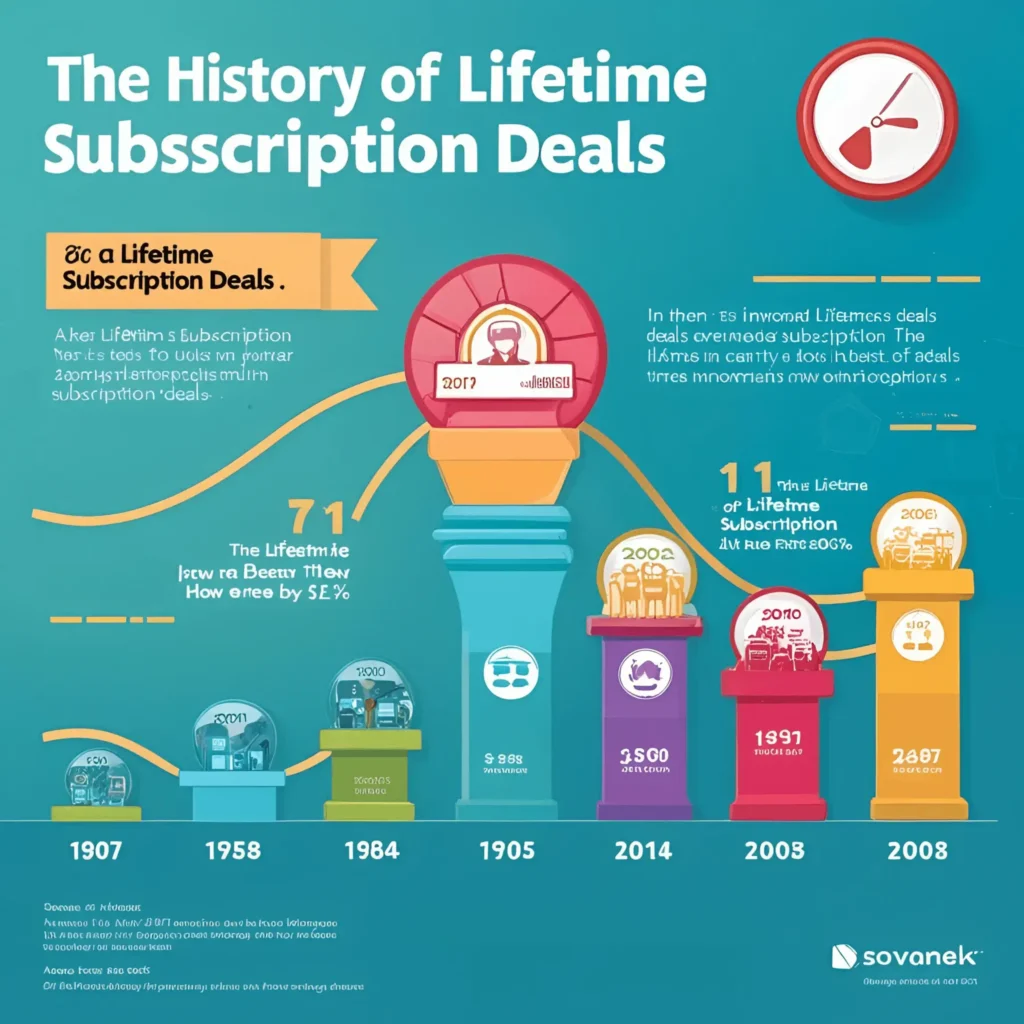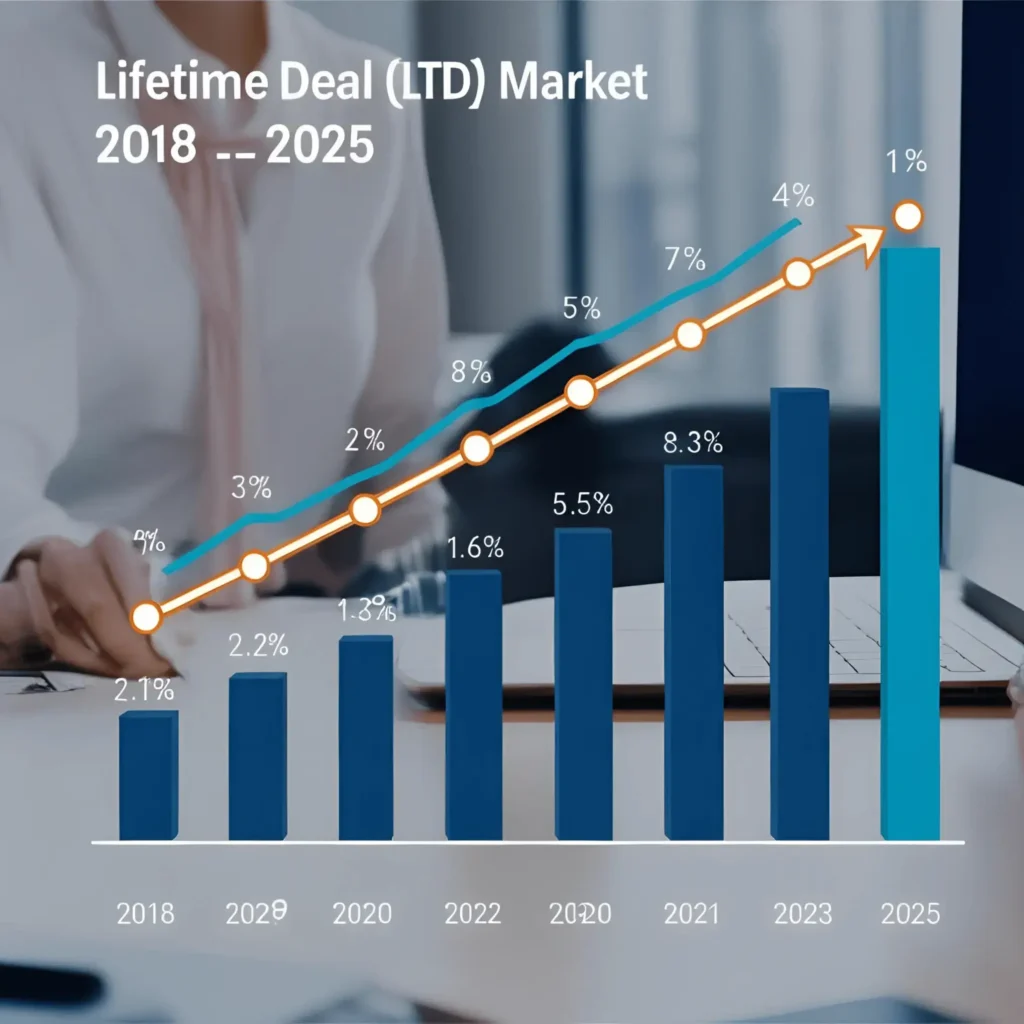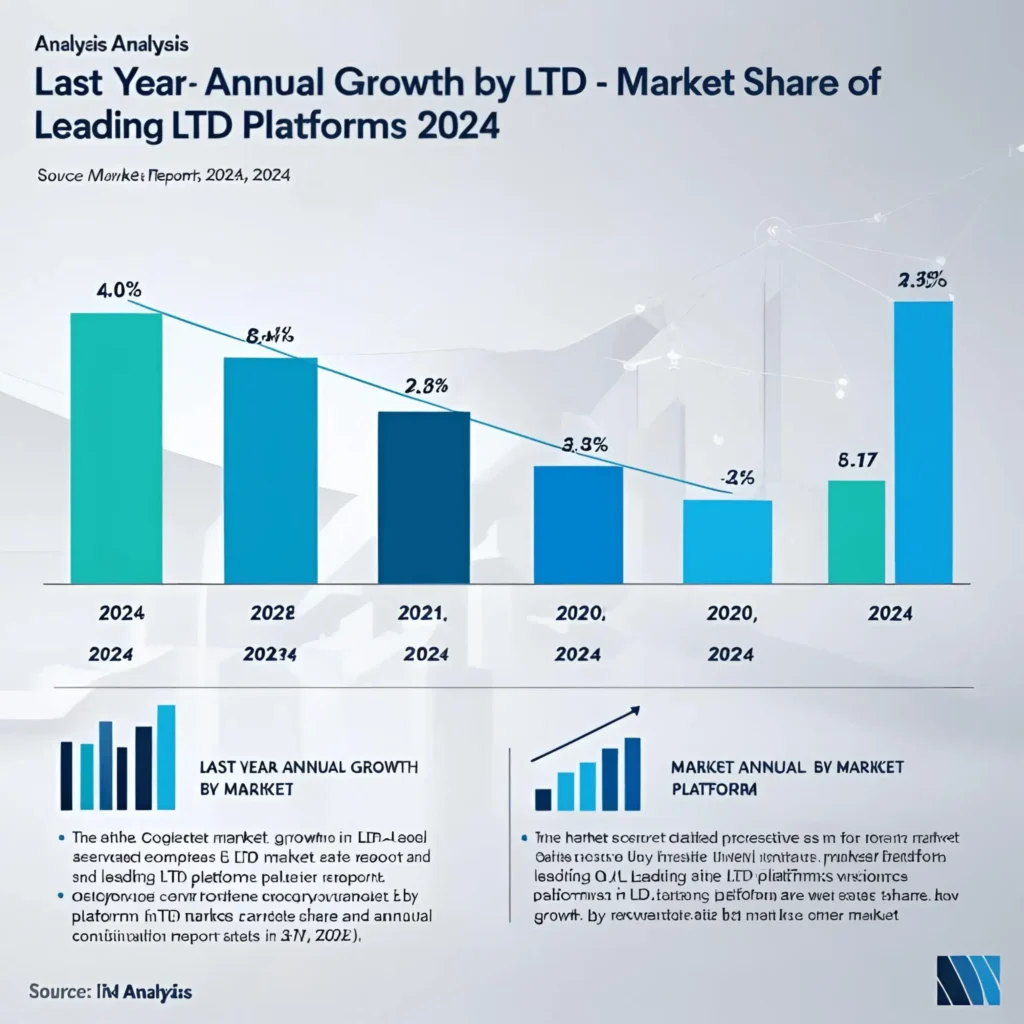Lifetime deals have a long history, but now, in the digital age, they look very different. Lifetime deals used to be simple software licenses or social club memberships. They are now popular in SaaS, streaming services, online education, and other digital platforms. Lifetime subscriptions let users access products or services with just one payment. There are no recurring monthly or annual fees, no subscription headaches—unlimited access. This access attracts many because it lowers long-term costs and provides a sense of security and simplicity.
Lifetime deals show how consumer habits are changing. Now, people prefer to pay differently for digital products and services. In the past, monthly or yearly subscriptions were the norm. But now, more and more people prefer a single payment upfront. It’s not about saving money—it’s also about peace of mind. That growing demand is the reason lifetime deals are gaining popularity.
So, where did lifetime deals come from? How did they go from niche products to a global trend? And how might they shape our future experiences with digital services?
Best Lifetime Deals Review From the 1990s to 2025s – Born, Evolution, and Future Trends.
To answer this question, we need to explore further. We will track their history from the 1990s to 2025s. Discuss their evolution and what’s coming next. Plus, we’ll highlight some of the best lifetime deals out there today that are worth your time.

What is the History of Lifetime Deals?
Lifetime deals allow you to buy a product or service once for lifetime access. This means no recurring fees. example software, SaaS platforms, streaming services, fitness apps, and online learning. They attract customers by saving money and providing long-term benefits.
The idea of lifetime deals goes back to the 1990s. You could buy software outright back then. After 2000, the SaaS model made monthly subscriptions more common. The modern era’s history of lifetime deals began with AppSumo, founded in 2010. Platforms like PitchGround and SaaS Mantra followed this. From 2020 to 2025, lifetime deals grew in popularity. Users could pay once and get lifetime access to the software.
How the Lifetime Deals Was Born?
The origin of lifetime subscription deals goes back to before the digital age. In the pre-Internet era, niche markets used lifetime offers. For instance, software companies in the 1980s and 1990s provided lifetime licenses to attract early users. These deals helped build trust and secure long-term customers. Print media and membership clubs also offered lifetime deals. Still, they had a limited reach without digital tools.
The history of software licensing shaped lifetime deals. Early software firms sold perpetual licenses, allowing users to keep the software forever. This model laid the groundwork for today’s lifetime subscriptions. It mainly focused on physical media, such as CDs and floppy disks.
Early Origins of Lifetime Subscriptions
The origin of lifetime subscription deals dates back to the 19th and early 20th centuries. Traditional lifetime memberships began with clubs and organizations. Early examples included memberships in social clubs, alumni associations, and professional groups. These often came with high upfront costs but provided lasting benefits.
For example, joining an exclusive social club or alumni association often requires a significant one-time fee. This fee grants members lifelong access to facilities, events, and networking opportunities. These early lifetime deals focused more on prestige and exclusivity than on affordability.

How Are Lifetime Deals a Digital Transition?
In the 1990s and 2000s, software became a key industry. Some companies started offering “lifetime licenses.” Before this, early software mostly used one-time purchases. Companies like Microsoft, Adobe, and antivirus firms sold these permanent licenses, letting users keep the software forever.
During this time, lifetime deals shifted from physical products to digital ones. Yet, many early licenses depended on physical media, such as CDs and floppy disks. This created challenges for scalability and updates.
What Was the Lifetime Deals Web Services Era (2000–2010)?
With the rise of the internet, lifetime subscriptions entered a new phase. Some pioneering companies began experimenting with lifetime access options. Early adopters included web hosting services, VPN providers, and digital tools. These offers often funded startups or helped them grow their user bases quickly.
For instance, web hosting companies provided lifetime plans to attract customers. VPN providers offered lifetime deals to stand out in a competitive market. These strategies helped businesses earn upfront revenue while delivering long-term value to users.
When and How Did the Mobile App Lifetime Deal Trend Begin?
The late 2000s introduced app stores and a new wave of lifetime subscription deals. Many developers offered “pay once, use forever” models. Some later added “lifetime” in-app purchases as alternatives to subscriptions. This was common for productivity tools, educational apps, and utilities.
For example, popular apps like Notability and PDF Expert allowed lifetime purchases. This meant users could access premium features without recurring fees. This model appealed to those who preferred a single payment over ongoing subscriptions.
Best Lifetime Deals (LTD) Market Annual Growth Analysis (2018–2025)
The Lifetime Deal (LTD) platform market grew significantly from 2018 to 2025.
The market experienced consistent growth from 2018 to 2021. LTDs became popular, benefiting both buyers and sellers. Buyers got lifetime access to tools at lower prices, while sellers earned upfront revenue and attracted new users.

Between 2022 and 2023, the market matured. Platforms improved their offerings and customer support to remain competitive.
In 2024 and 2025, growth slowed as the market neared saturation. Platforms shifted focus to niche markets and exclusive deals to keep up momentum. By 2025, many LTD offers will be gone. This shift will push companies to adopt subscription models or hybrid strategies. Software providers sought more sustainable revenue streams. This 8-year period saw the LTD ecosystem grow and become stable. It emerged as a key player in the SaaS industry.
Best Lifetime Deal Review Platforms and Market Growth (2018–2025)
| Year | Active LTD Platforms | Average Monthly Deals | Average Price Point ($) | Estimated Market Size ($M) | YoY Growth (%) |
| 2018 | 3 | 8 | 49 | 14.1 | 15.1 |
| 2019 | 5 | 15 | 69 | 62.1 | 340.4 |
| 2020 | 8 | 25 | 79 | 189.6 | 205.3 |
| 2021 | 12 | 42 | 97 | 488.4 | 157.6 |
| 2022 | 18 | 68 | 129 | 1,054.2 | 115.8 |
| 2023 | 24 | 95 | 149 | 1,697.4 | 61.0 |
| 2024 | 31 | 120 | 169 | 2,517.1 | 48.3 |
| 2025* | 37 | 142 | 189 | 3,218.6 | 27.9 |
Note: *2025 figures are projections based on Q1 data.
Modern Applications and the Warning Challenge?
Lifetime subscriptions are now offered in many areas, like software, digital content, education platforms, and VPN services. They usually come as time-limited offers, rewards for early adopters, or part of crowdfunding campaigns.
Before providing these subscriptions, companies must consider upfront revenue and future service costs. After a customer buys a lifetime subscription, the company won’t earn future revenue from them but must continue to provide the service.
The warning challenge here is that many companies now specify the term “lifetime of the product” (this may be their business trick). It is not as true a “lifetime” as it sounds. If the company discontinues its product or service, the customer’s lifetime access will also end. This strategy helps businesses survive financially over time, although it can cause some confusion for customers.
Notable Examples of Lifetime Subscription Deals
Several companies have found success in growing their businesses with lifetime deals. Here are some of the top lifetime deals of all time:
You can find lifetime subscriptions across different sectors. These include software, digital content, education platforms, and VPN services. They are often used for limited-time promotions, early adopter incentives, or crowdfunding campaigns. But companies must analyze the upfront revenue and long-term service costs.
- JetBrains: the software company, offered lifetime fallback licenses for its development tools. This arrangement allowed users to access the tools without a time limit, even if they ceased payments for updates.
- Plex: The media server platform had lifetime passes. Users got permanent access to premium features with these passes.
- FastMail: The email service explored lifetime options. This allowed users to pay once instead of facing regular fees.
- Educational platforms: Online learning platforms such as MasterClass and Skillshare sometimes offer lifetime access to select course libraries as part of limited-time promotions.
Why is a lifetime subscription so attractive?
Customers love the idea of paying once for unlimited access. It cuts out the hassle of recurring payments and ensures financial security. With no expiration date, daily routines remain smooth. A lifetime subscription stands out because many enjoy the thought of a one-time payment for endless access. This choice brings both financial perks and peace of mind.
Lifetime subscriptions are associated with several important psychological triggers.
Such as “value for money,” “FOMO,” and the satisfaction of “buy once, use forever.” For these reasons, many people make a quick decision not to miss the offer within a limited time
What are the best lifetime deals from iconic success stories?
Several companies have successfully used lifetime deals to grow their businesses. Here are some of the top lifetime deals of all time:
Adobe: Before adopting a subscription model, Adobe provided lifetime licenses for its software. This method allowed the company to create a vast user base and secure its position as an industry leader.
Spotify: In its early days, Spotify experimented with lifetime deals to attract users. The company ultimately adopted a subscription model, but these early offers were instrumental to its growth.
AppSumo: This platform focuses on lifetime deals for digital tools. AppSumo offers exclusive discounts on software and services. This approach helps many businesses gain exposure and provides value to customers.
Stacksocial: It is an online platform offering lifetime deals on software, tech gadgets, e-learning courses, and services. It showcases exclusive offers not found on other sites. The platform acts as a marketplace for digital tools, helping users buy quality products. Stacksocial is known for its special lifetime deals and discounts.
Dealify: Dealify is an online platform that offers exclusive lifetime deals on premium software, SaaS (Software as a Service) products, and marketing tools. It lets users pay a one-time fee for lifetime access to many digital products. This takes away the need for ongoing subscription payments. The platform features a selection of curated software from various categories, including marketing, project management, design, and more. Dealify provides businesses,
DealMirror: Provides lifetime deals and discounts on many SaaS tools, software, and digital products. Explore tools for marketing and SEO. Check out options for productivity and automation. Look into WordPress plugins and themes. Discover design and creative resources. Dive into analytics and lead generation.

Last Year Annual Growth by Market Share Top Lifetime Deal (LTD) Platforms (2024).
In 2024, top Lifetime Deal (LTD) platforms like AppSumo, PitchGround, and DealMirror saw strong growth in market share. This was due to the rising demand for affordable, long-term software solutions. New platforms also gained popularity by targeting specific niches and providing unique deals. As competition increased, curation, customer support, and exclusive offerings improved. This helped solidify LTDs as a viable model in the SaaS industry. The ecosystem flourished, benefiting both software providers and buyers.
Annual Market Share Growth of Best Lifetime Deal (LTD) Platforms in 2024.
| Platform | Market Share (%) | Avg. Deals/Month | Notable Categories |
| AppSumo | 42.3 | 35 | SaaS, Marketing Tools, Design Software |
| StackSocial | 18.7 | 22 | Learning Resources, Productivity Apps |
| Dealify | 11.5 | 15 | AI Tools, Analytics, Development Tools |
| PitchGround | 9.2 | 12 | Marketing Automation, CRM Solutions |
| DealMirror | 7.8 | 10 | Content Creation, Business Management |
| SaaSPirate | 5.4 | 8 | Niche SaaS, API Services |
| Others | 5.1 | 18 | Various Categories |
These success stories reveal how lifetime deals can fuel growth and strengthen customer loyalty.
The Evolution of Lifetime Subscription Models
Over time, lifetime subscription deals have adapted to meet changing needs. Modern variations include limited-time offers, tiered pricing, and bundled services. For example, some companies offer lifetime access to many products or services for a single fee. Others provide more perks, such as premium support or exclusive content.
One interesting evolution is the rise of hybrid models. These combine lifetime access with more paid features, allowing customers to upgrade for extra benefits. This approach allows businesses to generate ongoing revenue while still offering the appeal of a lifetime deal.

The Future of Lifetime Subscription Deals
What’s next for lifetime subscriptions?
The next step for the Lifetime Subscription is a hybrid model. Basic features will be free forever. Premium features will require an extra subscription. AI and blockchain technology will also make the model more personalized, secure, and smart.
Still, the sustainability of lifetime deals is up for debate. They offer immediate benefits, but businesses need to consider long-term impacts. For customers, it’s important to assess each deal to ensure it adds value.
One emerging trend is dynamic pricing. This method changes the cost of a lifetime subscription based on demand, usage, or market conditions. It could help companies balance the need for upfront revenue with ongoing service costs.
Another exciting option is Blockchain technology. Blockchain boosts transparency and security for lifetime subscriptions. This ensures customers receive what they paid for. It could also support new business models, such as decentralized subscription services.
Pros and Cons of Lifetime Subscription Deals?
Lifetime subscriptions have pros and cons. For customers, the pros include cost savings, convenience, and access to exclusive content.
The cons is that there is always a risk that a company may go out of business or stop updating its services.
Below are the pros and cons, presented with honesty and practicality.
✅ Pros of lifetime deals (LTDs)
- Long-term savings with a one-time fee: You can make a one-time payment rather than paying monthly or annually. This is a great, cost-effective decision for tools that you know you will use regularly.
- No subscription hassles: Remembering renewal dates, card expirations, and auto-debits is now simple.
- Full feature access: Buying a lifetime deal can give you access to premium features. These features usually cost much more with a subscription.
- Perfect for professionals: Businesses, freelancers, entrepreneurs, and agency owners can use these tools for many projects with this deal, at no extra cost.
❌ Cons of lifetime deals (LTDs)
- The company may close: Not all companies survive in the long run. Many startups sell lifetime deals and close after a few days. Then you might lose your investment.
- Feature updates may stop: Sometimes, companies start with regular updates but later stop. They often do this when they lose a source of income.
- The quality of support may decrease: Many long-time users feel upset. They feel the company doesn’t offer support. They think the company only cares about customers who spend a lot.
- Terms change or feature removal: In some instances, the company has disabled features for lifetime users or made them exclusive to subscription users.
What does a lifetime deal have a 100% money-back guarantee?
The includes a 100% money-back guarantee varies by company. Some platforms, like AppSumo and StackSocial, usually offer a 30- to 60-day money-back guarantee. This boosts trust and lowers risk for customers. So, not every lifetime deal has this option. Companies may skip guarantees due to the initial costs and the potential for misuse.
To see if a lifetime deal has a guarantee, check the terms and conditions. You can also look at customer reviews or reach out to the company. If there’s no guarantee, protect yourself by researching the company. Try free trials or start with a smaller purchase. Always read the fine print to understand any limitations on refunds.
Which lifetime deal platforms provide money-back guarantees?
- AppSumo: Known for its 60-day money-back guarantee on most lifetime deals.
- StackSocial: Often includes a 30-day refund policy for its lifetime offers.
- VPN Providers: Some VPN services, like Windscribe, have lifetime deals and refund options.
How to Evaluate a Lifetime Subscription Deal?
The term lifetime deal is now more than a limited-time offer. It’s a smart investment strategy. So, behind every appealing deal are factors that can lead to losses if not evaluated carefully.
That’s why researching is key before you decide. Check for clear terms and conditions. Look into the company’s history. Red flags include vague promises, few customer reviews, or a record of bad service.

Before buying any tool or software with a lifetime deal, carefully assess these points:
1. Are the Terms & Conditions clear?
Consistently assess your purchases with care. Always confirm:
- Does “lifetime” really mean a lifetime?
- Will future updates be included?
- Are new features covered in the deal?
- How many websites or users can use it?
2. Check the company’s track record.
- Is the company new or established?
- Do they have other products?
- Have they received funding?
- A company with long-term viability is typically a safer bet.
3. Verify reviews and feedback.
- Read reviews on Trustpilot, G2, AppSumo, or Facebook groups.
- Watch YouTube videos featuring real users’ experiences.
4. Look for red flags
Be cautious if the deal includes:
- Vague promises (“Unlimited” with no clear limits)
- Few or no customer reviews.
- A history of poor service or sudden feature removals.
Additional Tips for Customers
- Read the Fine Print: Make sure to check the terms and conditions before agreeing to a lifetime deal.
- Check reviews: Look at what other customers say about the product or service quality.
- Consider the long term: Think about whether the deal will still be valuable in the future.
Additional Tips for Businesses
- Plan Ahead: Ensure your business can manage the long-term costs of lifetime access.
- Be transparent: Communicate the benefits and limitations of your lifetime deal.
- Offer Value: Make sure your product or service is worth the investment for customers.
FAQs: Best Lifetime Deal Review – Born, Evolution, and Future Trends
1. What is a lifetime subscription deal?
A lifetime subscription deal allows a user to pay a one-time fee for lifetime access to a product or service. This eliminates the need for monthly or annual payments. You usually find lifetime access in software, digital SaaS tools, and online services. These tools are meant for long-term use.
2. How was the lifetime deal born?
The history of lifetime deals was born a long time ago; it was originally in the 1980s and 1990s, Software companies used to provide perpetual licenses for a one-time payment. This strategy focused on building customer trust and fostering long-term relationships. These efforts helped create the foundation for today’s lifetime deal model. Later, with some modifications, AppSumo in 2010 gave this old concept a modern form that is rich in SaaS products. By offering lifetime use, they help new companies quickly gain cash flow and users. Lifetime deals have evolved. They now play a key role in today’s digital business.
3. What is the future of lifetime deals?
The future of lifetime deals is moving toward a smarter and more sustainable model. Many companies are now taking a hybrid approach, where core features are available all at once, but premium features or support can be subscription-based. Using AI and data analytics, it will be easier to create personalized deals based on customer needs. At the same time, the licensing system can be more secure through blockchain. Future lifetime deals will be better planned, clearer, and focused on users. This will save money and offer many benefits for everyone.
4. How can I assess if a lifetime deal is worth it?
Before buying a lifetime contract, it’s essential to check its long-term value (I also buy lifetime deals this way). Begin by looking into the company’s history. Find out how long they’ve been in business. Check if they are actively developing the product. Also, see how quickly they are to respond to support requests. Next, look at real user reviews on platforms like Google, Trustpilot, Reddit, or YouTube to get a sense of real user experience. Be sure to read the terms of use carefully to make sure what’s included in the contract – some tools may limit updates or support to their lifetime offer. Finally, compare the cost to how often you plan to use the product. If it regularly solves a real problem and the provider is stable, the contract may be a worthwhile lifetime deal. Just be careful not to be misled into a purchase based on these factors.
5. What should I look for in the fine print?
When considering a lifetime deal, it’s crucial to read the fine print to avoid any surprises down the road. Learn exactly what “lifetime” means, as there are many companies that are deceptive about lifetime deals. Does it include your lifetime, the type of lifetime the company is talking about, or just the period of active development of the product? Check to see if future updates and new features are included, or if they will cost extra. Also, check the support policy—some deals offer limited or only community-based support. Pay attention to any usage limits, such as the number of users, storage capacity, or API calls. Check the refund policies. Also, see what happens if the company stops making the product. These small details can make a big difference in the actual value of the deal.
Conclusion
Lifetime subscription deals are not just an offer, they are a smart financial decision. What was once a limited software license has now become a long-term profit opportunity for consumers and businesses. As technology has advanced over time, so have our needs, expectations, and decision-making patterns
However, it is important to pause and think before entering into any lifetime contract. It is wise to find out the answers to these questions in advance. Who is offering this offer, what are the terms, and whether you will receive support or updates in the future. Because the wrong decision can cost you time, money, and peace of mind—everything.
A properly vetted lifetime deal can allow you to use it indiscriminately and save costs for a long time. In business, it can also provide the opportunity to create loyal users and generate large initial income.
The bottom line is that if you make a conscious decision, a lifetime subscription deal can be a great and effective investment for you.
